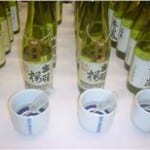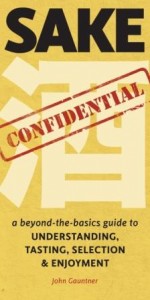 I usually write about the “nationals” in June, right after the competition takes place in May of each year. But some recently gleaned stats have compelled me to address it again this month. The contest is called the Zenkoku Shinshu Kampyoukai, which is translated as the “National New Sake Appraisal” but for some curious reason it is officially known in English as the “Japan Sake Awards.”
I usually write about the “nationals” in June, right after the competition takes place in May of each year. But some recently gleaned stats have compelled me to address it again this month. The contest is called the Zenkoku Shinshu Kampyoukai, which is translated as the “National New Sake Appraisal” but for some curious reason it is officially known in English as the “Japan Sake Awards.”
As many readers know, it is a blind tasting of sake that is specially brewed for this contest, basically daiginjo on steroids, i.e. intense in aromas and flavors, but exquisitely if precariously balanced. It can be amazing stuff, as is the skill to brew it the way it is, but its intensity is, well, intense. One small glass is plenty for most folks.
But that is not the point! The contest was created to give the brewers a chance to polish their skills and develop techniques that would make all of their sake better. Ostensibly, that is. And in any event the yearly competition has taken on a significance of its own. It is far and away the most prestigious event in the sake industry, yet the average consumer has no clue it exists or what its significance might be. And I am at a loss to explain that.
 There is an excellent sake promotion company called Fullnet in Tokyo, run by the inimitable Shigero Nakano. The small company runs big events that include massive junmai-shu only tastings and more. They also publish a handful of books with really good information that one cannot get elsewhere. For example, they publish a book that lists the company name, brand, address and contact information of every brewery in the country. And they include interesting tidbits like the 50-plus junmai only kura, or the kura brewing via women toji, or lists of the kura that ceased operations each year. And they also publish a yearly report in book form on the Japan Sake Awards. The below informaton has been culled from this year’s publication by Fullnet.
There is an excellent sake promotion company called Fullnet in Tokyo, run by the inimitable Shigero Nakano. The small company runs big events that include massive junmai-shu only tastings and more. They also publish a handful of books with really good information that one cannot get elsewhere. For example, they publish a book that lists the company name, brand, address and contact information of every brewery in the country. And they include interesting tidbits like the 50-plus junmai only kura, or the kura brewing via women toji, or lists of the kura that ceased operations each year. And they also publish a yearly report in book form on the Japan Sake Awards. The below informaton has been culled from this year’s publication by Fullnet.
The contest started in 1911 and has run every year but two; as such, this year was the 102nd running. According to the introduction, the first 44 times they ran the contest, the results were not officially made public, nor were the records kept. That’s it. Kaput. The first 44 may as well not have taken place. In a country with such a sense and awareness of history, this astounds me.
In 1956, they started to keep records, and kept them for each year since then save (inexplicably) two. But of the 54 or so, about 20 have gone missing from official archives. Nothing sinister, just no one thought they were worth keeping (which is sinister enough). But records exist with the companies that participated, and results have been dug up and gleaned from those.
The fact that so few official records remain from such a historically and culturally significant series of events is mind-boggling to me. Still, having hung out with sake for 26 years now, it is not surprising to me.
 There are many interesting statistics that exist – like longest runs of gold medals, or the most golds overall, or the most over the last ten years. About one fourth of the entries win a gold each in recent years, but nevertheless it is a significant accomplishment and hard to do with great regularity. As such, studying such data can help lead to a good idea of which companies have a significant industry presence.
There are many interesting statistics that exist – like longest runs of gold medals, or the most golds overall, or the most over the last ten years. About one fourth of the entries win a gold each in recent years, but nevertheless it is a significant accomplishment and hard to do with great regularity. As such, studying such data can help lead to a good idea of which companies have a significant industry presence.
As prestigious as the contest is, and as much as it has benefited the industry, it has had its dubious effects as well. The judges that assess such sake are with the central government and get transferred a lot. But the criteria they use to assess a sake are the same. So as they go from region to region, they end up influencing sake styles. And as such, traditional regional styles may have in some regions taken a back seat to winning medals and making ginjo-shu that would sell in the big cities.
For example, a sake that is rich and earthy and perhaps even a bit on the amber side might go well with the food, climate and culture of a particular region. But it would never win a gold medal, and would not likely sell in Tokyo. Often the judges would “ding” sake like that, influencing the style of that producer. These trends tend to gather critical mass, and the styles drip-down to lower grades of ginjo, and slowly regional styles fade into oblivion, replaced by more homogenous albeit tasty and refined profiles.
Everything in the Universe has a price. And that includes competitions that improve the image and quality of all sake as well.
~~~~~~~~~~~~~~~~~~~~~~~~~~~~~~~~~~~~~~~~~~~~~~~~~~~~~~~~~~~~
Be sure to look for my new book, Sake Confidential, available now at Barnes and Noble, Amazon, and the other usual suspects. Please check out the customer reviews on Amazon:
 In over two-dozen short essays presented in a very informal and conversational tone, “the truth about sake” is revealed. The truth about junmai types versus non-junmai types, the truth about the impossibly detailed craft of sake brewing, the truth about temperature, premium types, aging, purity, pasteurization and regionality are all touched upon.
In over two-dozen short essays presented in a very informal and conversational tone, “the truth about sake” is revealed. The truth about junmai types versus non-junmai types, the truth about the impossibly detailed craft of sake brewing, the truth about temperature, premium types, aging, purity, pasteurization and regionality are all touched upon.
How the industry works, its challenges and strengths, what really creates sake flavors and aromas, specs you can safely ignore, and what hype you can safely avoid are all fair game. You’ll learn what goes into sake pricing, and how brewers get their rice. How to choose sake, and how to improve your tasting ability are also part of the fun. Suffice it to say that nowhere else is so much detailed information about the realities of the sake world assembled together into one place.
– See more at the store!




